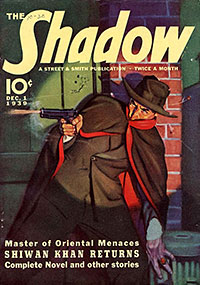 Probably one of the best-known pulp heroes, even among people who know nothing about pulp heroes, is The Shadow.
Probably one of the best-known pulp heroes, even among people who know nothing about pulp heroes, is The Shadow.
The Shadow is the pulp world’s Batman to Doc Savage as Superman. (So does this make Street & Smith the DC Comics of the pulp world? Is Popular Publications the Marvel? Thrilling the Archie Comics?) And the Batman analog is appropriate, as we’ve learned many Shadow novels were mined for Batman stories.
But I find that while many have heard of The Shadow, their knowledge of The Shadow is usually based on other media versions of the character, either one of the many comic book series or perhaps the movie, which mixes in elements from the radio and other versions of The Shadow.
For me, the one and true Shadow existed in the pulp stories by Walter Gibson, who created him, and Theodore Tinsley. (Yes, I am leaving out the pulp stories of Bruce Elliot.) Less true are the variations in radio, comics, and comic strips, and later books.
Now, while many people know of The Shadow through the radio show, it was really the pulp series that truly created and defined him, even if he started out in radio. This is because he started out as merely a mysterious narrator for a radio series highlighting stories from Street & Smith’s Detective Story Magaine, as a tie-in to boost sales.
When S&S editors learned that readers were asking newsstands for “that Shadow magazine,” they knew they needed to take advantage of this and protect the rights to the character. Editor Henry Ralston commissioned writer Walter Gibson to create the character. Ralston was familiar with the prior dime novel heroes who had their heyday in past decades, but had died out, such as S&S’s own Nick Carter.
They made a wise choice in Gibson, who was a magician and wrote for magicians, and who incorporated stage magic into the character, which is the basis for The Shadow’s “mystical abilities.” There was no mysticism. In fact, when you look closely at the character and elements that Gibson later revealed, you realize that what The Shadow was was basically a spymaster, applying those skills, along with stage magic, to fight crime.
In many of the early stories, The Shadow was more in the background, gathering information and figuring out what the villain was doing before he made his move. He had recruited a cadre of agents to aid him. And they were agents, not aides or partners like the other pulp heroes. None knew his real identity; they were not his pals; they didn’t hang out with him. Most remained doing their normal lives and jobs, but would step in as needed. Some merely gathered information and passed it along, such as Rutledge Mann (other agents were told to see “Our Man”: R. Mann), or the late Claude Fellows (“See Fellow”), or contact Burbank.
Harry Vincent was almost a proxy hero in the early stories, usually getting into situations where The Shadow had to extract him. Cliff Marsland and Hawkeye where his underworld contacts. Shrevvy the cab driver would chauffeur him around, and pilot Miles Crofton would take care of his autogyro. Most know Margo Lane, a creation of the later radio show who much later appeared in the pulps. And there are several others, many of whom only appeared in a few stories. It’s unfortunate that most of the comics series make little use of these many characters: Jericho Druke, Dr. Roy Tam, Slade Farrow, Myra Reldon and others.
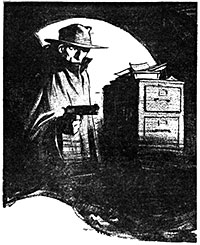 Who The Shadow is another matter people are unclear on. If they are familiar with the later radio show, they think he’s millionaire Lamont Cranston. But we who read the pulps know that’s not the case. In the second pulp story, he appears as Lamont Cranston. Then in the third story, Lamont Cranston returns from traveling abroad and is confronted by himself! It appears that The Shadow had been using Cranston’s identity to move within high society, and they come to an understanding. The real Cranston will travel abroad, allowing The Shadow to use his identity. This works out fine, until six years later Cranston is injured and The Shadow is forced to bring back his real identity, WWI aviator and spy Kent Allard. Which, to me, explains The Shadow as spymaster. Cranston would even occasionally show up and help out The Shadow. (Some feel that the later Bruce Elliot stories were really Cranston being a detective while The Shadow is elsewhere — works for me!)
Who The Shadow is another matter people are unclear on. If they are familiar with the later radio show, they think he’s millionaire Lamont Cranston. But we who read the pulps know that’s not the case. In the second pulp story, he appears as Lamont Cranston. Then in the third story, Lamont Cranston returns from traveling abroad and is confronted by himself! It appears that The Shadow had been using Cranston’s identity to move within high society, and they come to an understanding. The real Cranston will travel abroad, allowing The Shadow to use his identity. This works out fine, until six years later Cranston is injured and The Shadow is forced to bring back his real identity, WWI aviator and spy Kent Allard. Which, to me, explains The Shadow as spymaster. Cranston would even occasionally show up and help out The Shadow. (Some feel that the later Bruce Elliot stories were really Cranston being a detective while The Shadow is elsewhere — works for me!)
The Shadow had other identities he used. He would take on the role of Fritz the janitor who worked at police headquarters to spy on the cops, usually Det. Joe Cardona. He would also use the identity of businessman Henry Arnaud and elderly Isaac Twambley. What we never learn is any kind of origin. What lead Kent Allard to start his war on crime as The Shadow?
In the earlier stories, The Shadow went up against the usual gangsters, extortionists, criminals and the like, later even dealing with mad scientists, spies and foreign agents. Soon he was going up against more colorful “supercrooks” (what most might call super villains) with names like The Cobra, The Red Envoy, Zemba, Five-Face, The Death Giver, Silver Skull, Gray Fist, The Black Dragon, The Red Blot, The Black Falcon, The Black Master, The Gray Ghost, and Dr. Z. A handful of these actually showed up more than once.
The most well-known, and who most view as The Shadow’s main enemy is Shiwan Khan, who appeared in 4 adventures. Next is The Prince of Evil, Benedicy Stark, in four stories all by Tinsley. The Voodoo Master had three stories. The Hand was a group of five criminals, which The Shadow dealt with in five separate stories.
And thankfully, not all the stories were set in New York. The Shadow traveled to other cities to address crime there. Chinatown, in both New York and San Francisco, was a frequent location. Several were set in Washington, D.C.
The Shadow pulp ran for 325 issues from 1931 to 1949. For many years the series appeared twice a month, thus there are more stories than any other pulp hero. Gibson wrote the bulk of them, with Tinsley contributing about four a year during the twice a month period. Elliot wrote 15 before Gibson came back after a salary dispute.
It’s interesting that at the beginning, S&S kind of hedged their bets with the series. It started off as a quarterly, with a reused cover from Thrill Book. It sold so well, they bumped it to bimonthly with the second issue, then monthly with the third. A little over a year later, it was twice a month.
The Shadow sadly shared the same fate as other pulp heroes, though he lasted longer than most, being outlived by only a couple of the Thrilling heroes. He has thankfully lived on with new stories and in other media.
Radio
As noted, most know of The Shadow through the radio show. But it’s important to point out that this show didn’t start until about six years after the pulps started. And it was necessary to scale down the character and make some changes, like saying he was really Lamont Cranston.
It was in the radio show that the idea of The Shadow having mystic powers (“the power to cloud men’s minds” probably learned in the orient) was added. Margo Lane was created, as it was important to have a female voice to counterpoise with the male voices. The radio show outlasted the pulp series, running until 1954. Many episodes are available today on CD, though I am not aware of any attempt at a complete collection.
Movies/Serials
The Shadow has appeared in several movies and serials. First in the early ’30s was a series of six short films using The Shadow.
In the late ’30s, a pair of movies were released: “The Shadow Strikes” and “International Crime.” Both star Rod LaRocque as the Shadow.
A 15-chapter serial appeared in the 1940s called “The Shadow” starring Victor Jory as The Shadow.
Poverty Row studio Monogram then did a trio of Shadow movies in the late ’40s.
Interestingly, a pilot for a possible TV series of The Shadow done in the ’50s was turned into a movie called “The Invisible Avenger” (or “Bourbon Street Shadows”).
Finally, a major Shadow movie was made in the 1990s that started Alec Baldwin as The Shadow going up against Shiwan Khan. This Shadow was a mix of the pulp and radio versions.
There have been talk of a new movie, but who knows what will happen. But many of the above are available on DVD.
Comic Strips
For a brief time from 1940-42, a Shadow comic strip ran. Written by Gibson with art by Vernon Green, it adapted some stories from the pulps.
While a couple of publishers reprinted most of the strips in comic book form, no complete collection has been published. Sanctum Books does plan on putting one out, and I can’t wait.
Comics
The Shadow has appeared in several comic series over the years, not always true to the character.
The first was done by S&S and was their longest running comic series, from 1940-49. Written mainly by Gibson, it was aimed at a younger audience, though a few stories were based on pulp stories. There was also a “Shadow Jr.” character. I’ve only seen a few stories, usually in articles in the back of Sanctum Book’s Shadow reprints. I wish someone would reprint these stories.
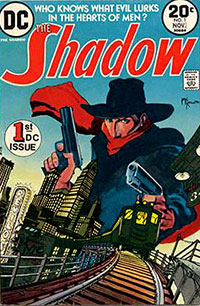 During the resurgence of superheroes in the ’60s, Archie Comics did a short-lived series that is probably the lowest point for the character in comics. Based more on the radio version, The Shadow first appeared as a blond jet-setting Lamont Cranston before he was turned into a campy muscle-bound “super hero” in a green and blue outfit who worked out in a “Danger Room” and went up against Shiwan Khan. The blog Section 244 did a full review of each issue recently, saving us the trouble of tracking down issues.
During the resurgence of superheroes in the ’60s, Archie Comics did a short-lived series that is probably the lowest point for the character in comics. Based more on the radio version, The Shadow first appeared as a blond jet-setting Lamont Cranston before he was turned into a campy muscle-bound “super hero” in a green and blue outfit who worked out in a “Danger Room” and went up against Shiwan Khan. The blog Section 244 did a full review of each issue recently, saving us the trouble of tracking down issues.
In the 1970s, we get what I consider the high point of the character in comics when DC Comics put out a short-lived series written by Denny O’Neil and drawn first by Mike Kaluta. These were more true to the character. A later issue had The Avenger showing up (probably to boost sales of his series). The issues by Kaluta have been reprinted and may still be found.
DC did another mini-series in the 1980s, written and drawn by Howard Chaykin that brought the character into the modern world. Chaykin took some (many?) liberties with the character, which upset some fans. This mini has recently been reprinted by Dynamite. This lead to a new series with art by Bill Sienkiewicz (issues 1-6) and Kyle Baker (issues 8-19 and two annuals). Dynamite is now collecting this follow-on series.
Around the same time, Marvel Comics did an original graphic novel set during WWII by O’Neil and Kaluta called “Hitler’s Astrologer.” This can still be found and is as good as O’Neil and Kaluta’s prior work.
DC canceled the prior series, and did a better series called “The Shadow Strikes,” set in the 1930s. It also featured a crossover with Doc Savage, which DC was also publishing.
Dark Horse then got the rights around the time of the movie, and put out several excellent mini-series, including one that teamed up Doc Savage and The Shadow. Sadly, none have been collected.
More recently, Dynamite has been publishing several Shadow comics. The main one started off with The Shadow being a bit out of character, being more violent than he should be and with mystic powers. With further stories by others, the comics got more in line with the real Shadow. It has recently ended, but is being collected in trade paperback. Other series included a mini that crossed over several pulp characters Dynamite was publishing called “Masks,” a sort-of origin story called “Shadow: Year One,” and another one set in modern times called “Shadow Now.” A new mini is planned, written and drawn by Chaykin, and set just after the pulp series ended and acting as a lead-in to his early mini series at DC.
New and Reprints
Since The Shadow pulp was canceled, there has been some efforts to bring back new stories and reprints.
When Archie Comics had the rights, their related paperback publisher Belmont Books commissioned a new Shadow novel from Walter Gibson. But instead of further new stories by Gibson, they commissioned Dennis Lynds to write new stories of a more spy-oriented Shadow, obviously influenced by the spy craze of the time. Other than a couple of short stories by Gibson, no new stories of The Shadow have appeared, unlike other pulp heroes. There are plans on reprinting Gibson’s novel, but I’m not aware of plans to reprint the others.
Thanks to the popularity of the Doc Savage pulp reprints, several publishers have tried their hands at reprints, including Bantam, but also Pyramid (with great covers by Jim Steranko). Pyramid did the most, with 23. It wasn’t until Anthony Tollins‘ Sanctum Books started their reprint series of two per volume (with some great extras) that we may see all The Shadow novels reprinted. At this time about 90 volumes have appeared.
Hopefully with this short intro to one of the greatest pulp heroes, that this will encourage people to check him out.

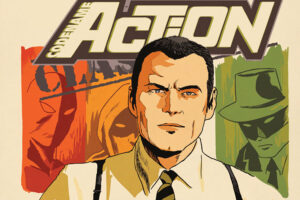
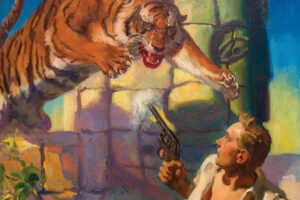
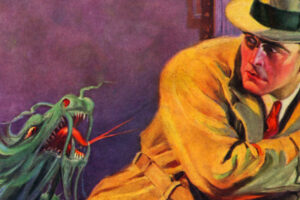
I just wish that someone would reprint these as e-books.
joe allegretti
no e-books please
I don’t have a problem with ebooks, so long as there are print versions available. (and frankly with POD, there is little excuse not to make such available).
I don’t like it when ebooks are the ONLY option.
I think of it as an untapped market for Shadow fans and pulp lovers in general. Ditto for Doc Savage!